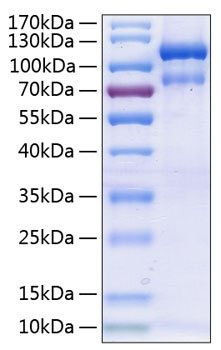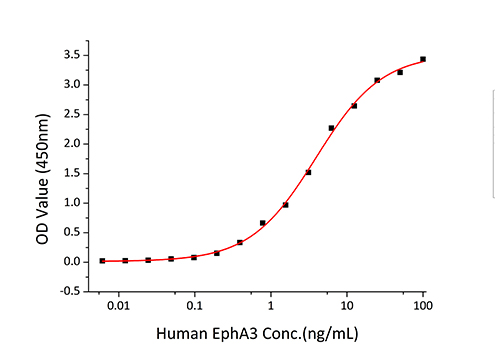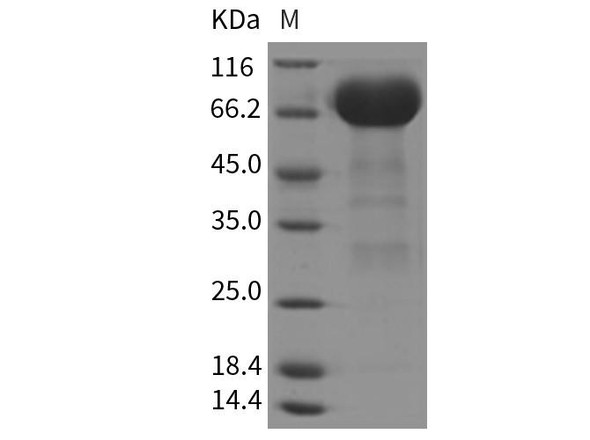Description
Recombinant Human EphA3 Protein
The Recombinant Human EphA3 Protein is a biologically active recombinant protein that plays a significant role in various cellular processes and signaling pathways in human biology. This protein is widely employed in immunological research, cell biology studies, protein-protein interaction analyses, and therapeutic development, providing researchers with a reliable tool for investigating EphA3 function and its implications in health and disease.
This product (SKU: RPCB0285) is produced using HEK293 cells and features a C-hFc&His tag for convenient detection and purification. The protein exhibits a calculated molecular weight of 87.75 kDa with an observed molecular weight of 90, 110 kDa under denaturing conditions, achieving ≥ 95 % as determined by SDS-PAGE.. Functional bioactivity has been validated through rigorous quality control assays, confirming its suitability for demanding research applications.
Key Features
| High Purity by Affinity Chromatography | |
| Mammalian & Bacterial Expression Systems | |
| High lot-to-lot consistency via strict QC |
| Product Name: | Recombinant Human EphA3 Protein |
| SKU: | RPCB0285 |
| Size: | 10 μg , 20 μg , 50 μg , 100 μg |
| Reactivity: | Human |
| Synonyms: | EK4, ETK, HEK, ETK1, HEK4, TYRO4, EPHA3 |
| Tag: | C-hFc&His |
| Expression Host: | HEK293 cells |
| Calculated MW: | 87.75 kDa |
| Observed MW: | 90, 110 kDa |
| Gene ID: | 2042 |
| Protein Description: | High quality, high purity and low endotoxin recombinant Recombinant Human EphA3 Protein (RPCB0285), tested reactivity in HEK293 cells and has been validated in SDS-PAGE.100% guaranteed. |
| Endotoxin: | < 0.1 EU/μg of the protein by LAL method. |
| Purity: | ≥ 95 % as determined by SDS-PAGE. |
| Formulation: | Lyophilized from a 0.22 μm filtered solution of PBS, pH 7.4.Contact us for customized product form or formulation. |
| Bio-Activity: | Measured by its binding ability in a functional ELISA.Immobilized Human EFNA5 at 0.5μg/mL (100 μL/well) can bind Human EPHA3 with a linear range of 0.01-3.9 ng/mL. |
| Reconstitution: | Centrifuge the vial before opening. Reconstitute to a concentration of 0.1-0.5 mg/mL in sterile distilled water. Avoid vortex or vigorously pipetting the protein. For long term storage, it is recommended to add a carrier protein or stablizer (e.g. 0.1% BSA, 5% HSA, 10% FBS or 5% Trehalose), and aliquot the reconstituted protein solution to minimize free-thaw cycles. |
| Storage: | Store at -20℃.Store the lyophilized protein at -20℃ to -80 ℃ up to 1 year from the date of receipt. After reconstitution, the protein solution is stable at -20℃ for 3 months, at 2-8℃ for up to 1 week. |
EphA3, also known as Cek4, Mek4, Hek, Tyro4, and Hek4, is a 135 kDa glycosylated member of the transmembrane Eph receptor tyrosine kinase family. EphA3 is expressed in the developing forebrain, retinal axons, some spinal cord motor neurons, and the heart where it plays an important role in axonal repulsion and organ morphogenesis. It is upregulated on some hematopoietic and solid tumor cells and on astrocytes surrounding injured nervous tissue. EphA3 ligation inhibits cellular adhesion to fibronectin as well as cellular migration. Transmembrane EphA3 associates in cis with ADAM10 which then promotes the cleavage in trans of Ephrin-A5. It also associates in cis with Ephrin-A5 on retinal axons, thereby preventing the activation of EphA3 by Ephrin-A.








